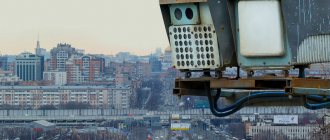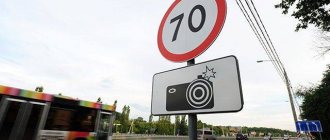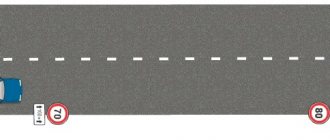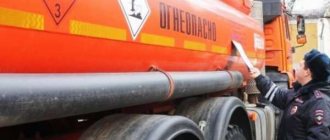Where are the cameras located? Official traffic police card
Yes, there is such a map in 2021. Under the auspices of crime prevention, instead of detection, the traffic police has released and maintains up-to-date an official map where you can see within the region and city where auto registration complexes are located.
The disadvantage of such a traffic police map is that it shows only stationary video cameras. Obviously, the portable tools will not be updated daily. But you won’t find these on other resources either - here only radar detectors can help.
View a map of traffic cameras in Russia on the official website of the State Traffic Safety Inspectorate.
To view the location of cameras, select your region in the drop-down list below the map and enlarge the map itself to find the road you need.
What types of fixation are there?
Most often, traffic police fines come from cameras when violations are recorded on stationary cameras. These are installed on poles and other supporting structures at the sides of transport arteries and monitor roads around the clock.
Different complexes have different technical characteristics, “farsightedness,” maximum fixation speed and a list of types of violations that they are ready to track.
In addition to them, portable video recording systems are used that “read” only speeding. Along with them, mobile traffic police cameras can also be used - in 2021 they will be installed on patrol cars and public transport. They see not only violations of the speed limit, but also non-compliance with parking rules, passage of heavy equipment and a number of other traffic violations.
And in some regions, the police have even begun to use drones and balloons, but this is more of an experiment than a rule. Let's take a closer look at the main video recording systems.
New cameras 2021
Let's start with the latest and simply new video recording systems that were installed on Russian roads not so long ago. Below we will show you how to find them on the map.
Hummingbird
This is one of the newest video recording systems, which is being actively installed in 2021 on Russian roads. On the map you can find them so far mainly in Moscow and Kazan, but they are also spreading in other cities.
The main advantage of the complex is its size, thanks to which they can be installed easily and in different places. Drivers often don’t notice them and therefore don’t slow down.
You will also be interested in:
- Traffic police cameras in Largus - how legal are they and what violations are they caught for?
- Can traffic police patrol in a civilian or private car, stop and fine?
- We drove under the camera at a yellow traffic light: will there be a fine and how to appeal?
Avtodoriya
This is a hardware and software complex that measures the speed of cars not using radars, but by mathematical calculations of the time it takes a recorded car to cover the distance between several recorders.
The system provides zonal speed control on road sections ranging from 250 meters to 10 km, and therefore it does not matter to the driver what distance he is from the recorder.
That is why there is no point in slowing down when passing Avtodoriya - it calculates the average speed in the section between two cameras.
Avtodoriya, in addition to speed, controls:
- intersection of dividing strips,
- detects violations of parking and stopping rules,
- records driving on the side of the road or in the public transport lane and other violations.
In addition, these traffic police cameras transmit online up-to-date information about the current traffic congestion. In 2021, you can find them on maps of Moscow, St. Petersburg, Kazan, Volgograd, Krasnodar and a number of others - mainly on highways near large cities.
You can see how Avtodoria records violations in the manufacturer’s official video.
Summary
Questions
1. Should the radar be mounted on a tripod?
1.1. Good afternoon Yes. must
2. So-called “tripods” have appeared on our roads, mobile radars that are installed in different places every day, without warning signs! Are such actions legal?
2.2. Good afternoon, dear Ekaterina. No warning signs are required for their use. Actions are legal Good luck to you and your loved ones!
3. Do they have the right to issue a fine for speeding from a Chris brand radar installed not in accordance with GOST? The radar was installed without a tripod, just on the ground.
3.1. Hello, yes, in the case of the CRIS radar this is possible, but it will be necessary to prove that it was installed incorrectly.
4. On the highway there are people in civilian clothes and in civilian cars, in front of the car there is a radar on a tripod with photo recording, is this legal?
4.1. and what do you see that is not legal??
5. On the highway there are people in civilian clothes and in civilian cars; in front of the car there is a radar on a tripod with photo recording. Are they doing this legally?
5.1. Hello! Fines from this camera will be illegal
6. Very often on the roads I see civilian cars with radars on tripods. 1. Please tell me, are private owners now allowed to record speeding violations? 2. What do you need to install such a radar yourself?
6.1. These are traffic police officers driving civilian cars.
7. What should I do if I was detected by a tripod radar at a speed of 90 km and there is no sign indicating that the radar is stationary.
7.1. Hello. If the offense is recorded by a video camera, then the owner of the vehicle is held accountable (Part 1 of Article 2.6.1 of the Code of Administrative Offenses of the Russian Federation). The owner of the vehicle is released from liability if, during the consideration of the complaint against the decision in the case of an administrative offense, it is confirmed that at the time the offense was recorded, the car was in the possession or use of another person or at that moment was, for example, stolen (Part 2 of Article 2.6 .1 Code of Administrative Offenses of the Russian Federation). Prepare a documented justification for your disagreement with the CCTV camera evidence. In your complaint, state the factual circumstances of the case, indicate your arguments and attach evidence to substantiate your position. In order to confirm your arguments, you can file a petition to request information about the location of road signs and road markings, as well as information from CCTV cameras about the details of the vehicle’s movement. The case of an administrative offense recorded by CCTV cameras is subject to consideration by the court at the place where it was committed (i.e. at the place where it was recorded by CCTV cameras) (Part 3 of Article 28.6, Part 1 of Article 29.5 of the Code of Administrative Offenses of the Russian Federation, paragraph 30 of the Resolution of the Plenum Supreme Court of the Russian Federation dated March 24, 2005 N 5). The deadline for filing a complaint is 10 days from the date of delivery or receipt of a copy of the decision. If there are good reasons, the missed deadline can be restored at the request of the person filing the complaint (Parts 1, 2, Article 30.3 of the Code of Administrative Offenses of the Russian Federation).
8. I was driving along the road with excess speed and came into the field of view of a portable radar on a tripod. Then I drove along expecting to see a patrol car, but it wasn’t there. A week later, a fine arrived in the mail. There were no markings or road signs about video recording on that section of the road. Is the fine legal?
8.1. And where in the traffic rules is there a clause stating that such video recording road signs should be installed? Therefore, if there was an excess of speed, then the fine is legal
Time-tested complexes
Strelka-CT
Perhaps the most common traffic police video camera on Russian roads is the Strelka ST. She can do the following:
- sees speed limit violators,
- controls traffic in the oncoming lane,
- on the side of the road,
- dedicated lane for public transport,
- crossing the stop line,
- movement of trucks in prohibited places and other violations.
The “vision range” of the camera exceeds 500 m. At this distance, it “catches” the violator in the traffic, “leads” him until he approaches a distance of 50 m, after which he records the violator and his license plate number using a camera. The downside of this system is that it does not respond to objects moving at speeds exceeding 180 km/h.
AvtoUragan-VSM2
This is not just a camera - it is a whole system that combines several photo-video recording complexes, which has a common time synchronization based on a signal from GLONASS/GPS. These traffic police cameras can record 17 types of traffic violations, including:
- over speed,
- driving on red,
- leaving the stop line,
- driving under a prohibiting sign,
- riding on tram tracks,
- sidewalks and bike paths.
The cameras see up to 4 road lanes, record objects at speeds of up to 255 km/h and provide accuracy with an error of no more than 2 km/h.
Odysseus
Autonomous stationary complex consisting of several cameras. It has 12 types of violations that it can capture, including:
- over speed,
- passing a prohibitory signal,
- driving into the oncoming lane,
- turning left or making a U-turn in violation of the markings,
- driving in the opposite direction on a one-way road, and so on.
The camera was created by TCOBDD LLC and reacts to objects moving at speeds of up to 250 km/h. The estimated error is ±1 km/h, the range of operation is classified by the manufacturer. In addition to recording traffic rules, the complex checks license plates for their presence in databases, for example, on the wanted list.
Krechet-SM, SKAT, SKAT-RIF, SKAT-PP
A series of cameras produced by Olvia LLC. Each of them has exceptional specific features. For example, KRECHET-SM provides continuous control with photo recording of all vehicles, SKAT can be used as a stationary or mobile fixing complex, SKAT-RIF works on the same principle as Avtodoriya, providing a mathematical calculation of the speed of movement.
And SKAT-PP is a traffic police camera designed to “catch” traffic violations in the pedestrian crossing area.
Krechet sees intruders in the range of 10-100 m, SKAT in the range of 5-50 m, and for SKAT-RIF such a range does not matter at all. Any of the systems recognizes violators if they move within 250 km/h.
Something else useful for you:
- Is it possible not to pay traffic fines and how?
- Is it possible to order and legally drive without a fine with license plates without the Russian flag?
- The traffic police inspector saw/filmed the violation, but didn’t stop it – what will happen?
Parkon-S
This complex is designed primarily to identify violators of stopping and parking rules. Parkon-S includes several PTZ street cameras controlled from a single center. Today you can find these funds on the maps of most Russian cities.
The system records cars parked in a given area and sends information about them to a single center: two photos with the date and time, license plate number, location and other information. Sees violators both on his own and on the opposite side of the road.
VOCORD Traffic
The VOCORD Traffic system is capable of recording 15 types of violations, including:
- speed limit violation;
- violation of intersection crossing rules;
- intersection of solid lines;
- violation of parking and stopping rules;
- violation in the pedestrian crossing area, etc.
The complex can include various components and measure speed using both detectors (up to 300 km/h) and optics (up to 250 km/h). The developers claim that the system is not recognized by radar detectors, provides 97% reliability of license plate recognition and passes less than 2% of total traffic.
Traffic police radar ranges in Russia
Police road radars use several standardized carrier radio frequencies, the most basic of which is the frequency of 10525 MHz, called the X-band. The main traffic police radars are Barrier, Sokol, etc., which are easily detected by radar detectors over a fairly large distance. At the moment, it has practically become obsolete and is not used in the Russian Federation. More often used in the CIS countries.
| Barrier-2-2M | Sokol-M |
Newer range for traffic police radars, frequency 24150 MHz. The most important range for Russia.
The frequency has shorter duration, higher energy potential, detection range, and much less interference compared to X-band.
Traffic police radars using this frequency: Berkut, Iskra-1 and their modifications and photo and video complexes built with the participation of the location parts of these radars. Also easily detected by detectors. Almost all cameras and speed meters operate in this range. Including Strelka ST/M.
| Iskra-1D | Strelka-ST |
The newest range for police radars, frequency 34700 MHz. Detection range up to 1.5 km with high accuracy in a minimally short time. The most promising range due to the shorter period and high potential. Radar detectors are also detected. In the Russian Federation it is not used at all. Busy with the military. Can be found in the CIS countries and Europe.
One of the rare bands used in some European countries. In Russia, satellite television operates on this range, so such traffic police radars in Russia Although there are plenty of them in Europe and even in the Baltics.
In almost all European countries and some American states, local legislation prohibits the use of radar detectors.
To ensure the capture of an illegal device, there are several special highly sensitive radars operating at a frequency of 13000 MHz, called VG-1, VG-2, VG-3 and similar.
The essence of the technology is this: the car is irradiated by this radar. A radar detector, overwhelmingly based on a superheterodyne, will process this signal.
During the process of amplifying this signal and before it is processed in the radar detector, the radar detector will broadcast this echo signal. That is, the usual and inevitable emission of an amplified signal will occur for a heterodyne amplifier. The VG-2 radar detects this echo and indicates that there is a high probability of a radar detector in that place.
To protect yourself and the owner’s wallet, nowadays almost all radar detector manufacturers have taken care of this and have various masking technologies from intruders. Removed from service in 2012. Replaced by Specter. In Russia, radar detectors are allowed. Therefore, if the radar detector has this function, then you can safely turn it off.
Since the beginning of the 90s, laser rangefinders and speed meters based on the reflection of a narrowly directed laser beam from an obstacle first appeared.
The speed was calculated using simple algorithms, by delivering several short pulses after a strictly defined period of time, measuring the distance to the target from each reflection of this pulse. As a result, a certain average component was obtained, which was displayed on the screen. The principle is simple and has not changed from then to the present day, but with each new round of evolution of such rangefinders, the pulse frequency and the length of the laser beam have changed. Almost all modern radar detectors have built-in sensors for receiving laser range. The accepted wavelength of which ranges from 800 nm to 1100 nm.
There are also disadvantages inherent in devices used in the laser range - they do not like dispersive obstacles (precipitation, fog, etc.), as a result of which these devices are used only in dry weather. The presence of reception in this range is important for the most part only in megacities, where traffic police officers have expensive equipment for monitoring speed limits.
Consult and choose the model that suits you
radar and purchase all the new products in the automotive radar detector market.
you can in our online store www.topradar.ru
Mobile and mobile cameras
In addition to stationary ones, the traffic police use cameras in mobile and portable systems. Their use has not become so widespread, since the key condition for their use is control by employees. And the point is not even in ensuring their functionality, but in the fact that such cameras can simply be stolen from the side of the road. The most common such systems are:
- KRIS-P is a mobile photo radar complex that mainly “catches” speeding with the ability to transmit results via a radio channel of data and frames to a remote mobile post;
- ARENA is a mobile system for auto-photo recording of traffic violations, detecting violators on a controlled section of the road, measuring their speed, photographing the violator and transmitting the results to a remote computer via a radio channel;
- AMATA is a laser radar with a wide range of speed measurements from 1.5 to 280 km/h. The minimum distance for measurements is 15 m. It is controlled by traffic police officers using a remote control and provides targeted sampling from the traffic flow.
Radar tripod
Tripods are most often used on federal highways.
The portable “Arena” hits one and a half kilometers. This is, in fact, the same automatic fixation camera, only mobile. There is no obligation to warn drivers about the operation of such a complex. Tripods are most often used on federal highways. The portable “Arena” hits one and a half kilometers. This is, in fact, the same automatic fixation camera, only mobile. There is no obligation to warn drivers about the operation of such a complex.
The main condition for the cameras to work is the presence of indisputable evidence of the driver’s guilt. But many mobile radars have problems with this. The fact is that some portable speed detection systems do not have the technical ability to record a violation (photos or video). These are the so-called “hair dryers”. They show only numbers (the speed of the object caught in the sight), and there is no connection to a specific car. And this is already a reason for the driver’s disagreement - this way anyone can be labeled as a violator.
After all, this is what happens on the road. You are driving calmly, and then a traffic police inspector stops you. In his hands is the same “hairdryer”, on which the numbers with your speed-violation are emblazoned. But, firstly, there is no evidence that this is exactly your speed. Secondly, it is generally unclear who and when the inspector caught at gunpoint.
Innovations from the traffic police: quadcopters and balloons
Not long ago, traffic police officers took it further - now in their arsenal they also have flying cameras placed on drones and balloons. Their use was first tested back in 2021, but they are not in permanent service until now in 2021.
Of course, they are not so “smart” and cannot independently determine the presence of a traffic violation and transmit information about this to a single center. However, they may well play the role of the “remote eyes” of the inspector and record offenses using a camera. The main thing is that it is an official traffic police camera, which has passed a meteorological check and was certified in accordance with GOST R 57145.
Of course, copters and balloons will not be able to determine the speed of the car. But the location of stationary traffic police cameras is not possible in all places, which cannot be said about the use of aerial equipment. In addition, they can be used without problems in places where there is a significant concentration of cars and help identify violations such as:
- intersection of double solid;
- driving into the oncoming lane;
- violation of travel rules at unregulated pedestrian crossings;
- driving to the side of the road, sidewalk, bike path;
- violation of overtaking rules and so on.
In the meantime, the operation of such means of fixation is not automated, the main thing is that the aircraft are reliable and do not fall on the roofs of cars or the heads of pedestrians!










